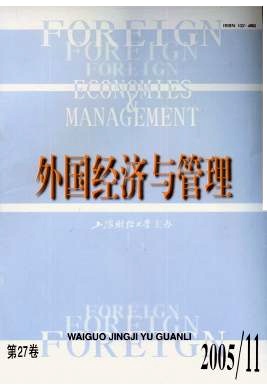当代西方营销理论的三大中心议题——真实性、解放、关系
外国经济与管理 2005 年 第 27 卷第 11 期, 页码:
摘要
参考文献
摘要
20世纪80年代以来,西方营销学者提出的几乎所有已经产生重要影响的营销新概念,都离不开三大中心议题:真实性(authenticity)、解放(liberation)和关系(relation-ship)。通过对这三大议题的分析,文章认为,承认当代消费文化的多元性和复杂性,并在此基础上对各个不同的营销概念加以整合,才是更具现实意义的选择。
[1]Gilles Marion.Marketing ideology and criticism:1960-1990[Z].Lyon:EGOS 17thColloquium,2001.
[2]Jean Baudrillard.Simulations[M].New York:Semiotexte,1983:148.
[3]A Faut Firat.The consumer in postmodernity[J].Advances of Consumer Research,1991,18:5-10.
[4][英]迈克.费瑟斯通.消费文化与后现代主义[M].南京:译林出版社,2000.
[5]Douglas B Holt.Why do brands cause trouble?a dialectical theory of consumer culture and branding[J].Journal of Con-sumer Research,2002,(Jun.):1-64.
[6]K Wattanasuwan.The self and symbolic consumption[J].Journal of American Academy of Business,2005,6(1):179-184.
[7]B Cova.The postmodern explained to managers:implications for marketing[J].Business Horizons,1996,(Nov./Dec.):15-23.
[8]R W Belk.Possessions and the extended self[J].Journal of Consumer Research,1988,15(2):139-168.
[9]R Elliott.Addictive consumption:function and fragmentation in postmodernity[J].Journal of Consumer Policy,1994,17:159-179.
[10]王长征,周玲.面向“联系价值”的后现代部落营销[J].外国经济与管理,2005,27(2):51-58.
[11]Bernard Cova.Community and consumption towards a definition of the“linking value”of product or services[J].Euro-pean Journal of Marketing,1997,31(3/4):297-316.
[12][英]齐格蒙.鲍曼.后现代性及其缺憾[M].上海:学林出版社,2002.
[13]A Faut Firat and Alladi Venkatesh.Liberatory postmodernism and the reenchantment of consumption[J].Journal ofConsumer Research,1995,22:239-267.
[14]A Faut Firat and Clifford J ShultzⅡ.From segmentation to fragmentation markets and marketing strategy in the post-modern era[J].European Journal of Marketing,1997,31:183-207.
[15]B Cova and V Cova.Tribal marketing:the tribalisation of society and its impact on the conduct of marketing[J].Euro-pean Journal of Marketing,Special Issue:Societal Marketing,2002:1-23.
①在后现代社会,文化的创新并非源自精英阶层,而是大众和街头。因此,实际上是大众而非精英成为了后现代的文化中心或源头。
②皮格马利翁系希腊神话中的塞浦路斯国王,热恋自己雕塑的少女像。这里借用皮格马利翁来意指个人主义的极端发展所导致的极端自恋的个体。
③相对于现代社会而言,产品(传统意义上的产品)与形象之间的关系在后现代社会被颠倒了:在现代社会,形象表达了产品,而价值是产品的所有物;在后现代社会,价值依附于形象,而产品是形象的表达(Firat,1992)。
④尽管怀旧,但他们并不排斥,而且实际上总是在极力寻求从未有过的,更加新奇、强烈的感官刺激和情感体验。
⑤Holt(2002)已深刻地洞察到了这一点:消费者尽管在消费中对品牌进行着这样或那样的抵制,甚至是对品牌的符号意义进行颠覆,但“总体上消费者并不拒绝品牌。相反,只有被察觉过于带有强制性的品牌才会失去人们的支持。”他还发现,在人们抵御公司的强制时,已确立的品牌变得更受推崇,而不是更没有价值。
[2]Jean Baudrillard.Simulations[M].New York:Semiotexte,1983:148.
[3]A Faut Firat.The consumer in postmodernity[J].Advances of Consumer Research,1991,18:5-10.
[4][英]迈克.费瑟斯通.消费文化与后现代主义[M].南京:译林出版社,2000.
[5]Douglas B Holt.Why do brands cause trouble?a dialectical theory of consumer culture and branding[J].Journal of Con-sumer Research,2002,(Jun.):1-64.
[6]K Wattanasuwan.The self and symbolic consumption[J].Journal of American Academy of Business,2005,6(1):179-184.
[7]B Cova.The postmodern explained to managers:implications for marketing[J].Business Horizons,1996,(Nov./Dec.):15-23.
[8]R W Belk.Possessions and the extended self[J].Journal of Consumer Research,1988,15(2):139-168.
[9]R Elliott.Addictive consumption:function and fragmentation in postmodernity[J].Journal of Consumer Policy,1994,17:159-179.
[10]王长征,周玲.面向“联系价值”的后现代部落营销[J].外国经济与管理,2005,27(2):51-58.
[11]Bernard Cova.Community and consumption towards a definition of the“linking value”of product or services[J].Euro-pean Journal of Marketing,1997,31(3/4):297-316.
[12][英]齐格蒙.鲍曼.后现代性及其缺憾[M].上海:学林出版社,2002.
[13]A Faut Firat and Alladi Venkatesh.Liberatory postmodernism and the reenchantment of consumption[J].Journal ofConsumer Research,1995,22:239-267.
[14]A Faut Firat and Clifford J ShultzⅡ.From segmentation to fragmentation markets and marketing strategy in the post-modern era[J].European Journal of Marketing,1997,31:183-207.
[15]B Cova and V Cova.Tribal marketing:the tribalisation of society and its impact on the conduct of marketing[J].Euro-pean Journal of Marketing,Special Issue:Societal Marketing,2002:1-23.
①在后现代社会,文化的创新并非源自精英阶层,而是大众和街头。因此,实际上是大众而非精英成为了后现代的文化中心或源头。
②皮格马利翁系希腊神话中的塞浦路斯国王,热恋自己雕塑的少女像。这里借用皮格马利翁来意指个人主义的极端发展所导致的极端自恋的个体。
③相对于现代社会而言,产品(传统意义上的产品)与形象之间的关系在后现代社会被颠倒了:在现代社会,形象表达了产品,而价值是产品的所有物;在后现代社会,价值依附于形象,而产品是形象的表达(Firat,1992)。
④尽管怀旧,但他们并不排斥,而且实际上总是在极力寻求从未有过的,更加新奇、强烈的感官刺激和情感体验。
⑤Holt(2002)已深刻地洞察到了这一点:消费者尽管在消费中对品牌进行着这样或那样的抵制,甚至是对品牌的符号意义进行颠覆,但“总体上消费者并不拒绝品牌。相反,只有被察觉过于带有强制性的品牌才会失去人们的支持。”他还发现,在人们抵御公司的强制时,已确立的品牌变得更受推崇,而不是更没有价值。
引用本文
王长征. 当代西方营销理论的三大中心议题——真实性、解放、关系[J]. 外国经济与管理, 2005, 27(11): 0.
导出参考文献,格式为:





 5635
5635  0
0

